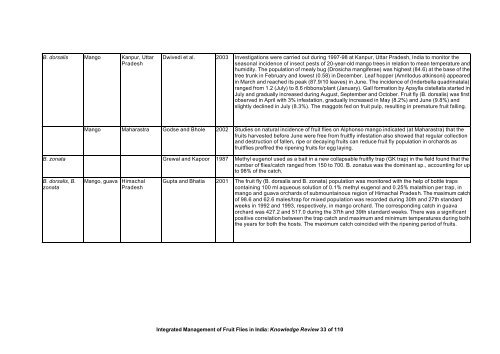“Key Informant Survey” of Production, Value, Losses and ... - DfID
“Key Informant Survey” of Production, Value, Losses and ... - DfID
“Key Informant Survey” of Production, Value, Losses and ... - DfID
Create successful ePaper yourself
Turn your PDF publications into a flip-book with our unique Google optimized e-Paper software.
B. dorsalis Mango Kanpur, Uttar<br />
Pradesh<br />
Dwivedi et al. 2003 Investigations were carried out during 1997-98 at Kanpur, Uttar Pradesh, India to monitor the<br />
seasonal incidence <strong>of</strong> insect pests <strong>of</strong> 20-year-old mango trees in relation to mean temperature <strong>and</strong><br />
humidity. The population <strong>of</strong> mealy bug (Drosicha mangiferae) was highest (84.6) at the base <strong>of</strong> the<br />
tree trunk in February <strong>and</strong> lowest (0.58) in December. Leaf hopper (Amritodus atkinsoni) appeared<br />
in March <strong>and</strong> reached its peak (87.9/10 leaves) in June. The incidence <strong>of</strong> (Inderbella quadrinatala)<br />
ranged from 1.2 (July) to 8.6 ribbons/plant (January). Gall formation by Apsylla cistellata started in<br />
July <strong>and</strong> gradually increased during August, September <strong>and</strong> October. Fruit fly (B. dorsalis) was first<br />
observed in April with 3% infestation, gradually increased in May (8.2%) <strong>and</strong> June (9.8%) <strong>and</strong><br />
slightly declined in July (8.3%). The maggots fed on fruit pulp, resulting in premature fruit falling.<br />
Mango Maharastra Godse <strong>and</strong> Bhole 2002 Studies on natural incidence <strong>of</strong> fruit flies on Alphonso mango indicated (at Maharastra) that the<br />
fruits harvested before June were free from fruitfly infestation also showed that regular collection<br />
<strong>and</strong> destruction <strong>of</strong> fallen, ripe or decaying fruits can reduce fruit fly population in orchards as<br />
fruitflies preffred the ripening fruits for egg laying.<br />
B. zonata Grewal <strong>and</strong> Kapoor 1987 Methyl eugenol used as a bait in a new collapsable fruitfly trap (GK trap) in the field found that the<br />
number <strong>of</strong> flies/catch ranged from 150 to 700. B. zonatus was the dominant sp., accounting for up<br />
to 98% <strong>of</strong> the catch.<br />
B. dorsalis, B.<br />
zonata<br />
Mango, guava Himachal<br />
Pradesh<br />
Gupta <strong>and</strong> Bhatia 2001 The fruit fly (B. dorsalis <strong>and</strong> B. zonata) population was monitored with the help <strong>of</strong> bottle traps<br />
containing 100 ml aqueous solution <strong>of</strong> 0.1% methyl eugenol <strong>and</strong> 0.25% malathion per trap, in<br />
mango <strong>and</strong> guava orchards <strong>of</strong> submountainous region <strong>of</strong> Himachal Pradesh. The maximum catch<br />
<strong>of</strong> 98.6 <strong>and</strong> 62.6 males/trap for mixed population was recorded during 30th <strong>and</strong> 27th st<strong>and</strong>ard<br />
weeks in 1992 <strong>and</strong> 1993, respectively, in mango orchard. The corresponding catch in guava<br />
orchard was 427.2 <strong>and</strong> 517.0 during the 37th <strong>and</strong> 39th st<strong>and</strong>ard weeks. There was a significant<br />
positive correlation between the trap catch <strong>and</strong> maximum <strong>and</strong> minimum temperatures during both<br />
the years for both the hosts. The maximum catch coincided with the ripening period <strong>of</strong> fruits.<br />
Integrated Management <strong>of</strong> Fruit Flies in India: Knowledge Review 33 <strong>of</strong> 110

















